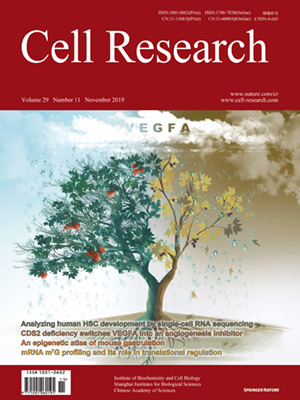
Volume 29, No 11, Nov 2019
ISSN: 1001-0602
EISSN: 1748-7838 2018
impact factor 17.848*
(Clarivate Analytics, 2019)
Volume 29 Issue 11, November 2019: 953-955
LETTERS TO THE EDITOR
Structure of the African swine fever virus major capsid protein p72
Qi Liu 1,2, Bingting Ma1, Nianchao Qian3, Fan Zhang3, Xu Tan 3,Jianlin Lei 4 and Ye Xiang1
1Beijing Advanced Innovation Center for Structural Biology, Beijing Frontier Research Center for Biological Structure, Center for Infectious Disease Research, Department of Basic Medical Sciences, School of Medicine, Tsinghua University, Beijing 100084, China; 2Tsinghua University-Peking University Joint Center for Life Sciences, Beijing,China; 3Beijing Advanced Innovation Center for Structural Biology,Beijing Frontier Research Center for Biological Structure, School of Pharmaceutical Science, Tsinghua University, Beijing 100084, China and 4Beijing Advanced Innovation Center for Structural Biology, Beijing Frontier Research Center for Biological Structure, School of Life Science, Tsinghua University, Beijing 100084, China
Correspondence: Ye Xiang (yxiang@mail.tsinghua.edu.cn)
African swine fever (ASF) caused by the African swine fever virus (ASFV) infection is a highly contagious and lethal disease of domestic pigs. Recent spread of the virus to China,1 the biggest pork-consuming country, has caused huge economic loss. So far there is no effective way to prevent the spread of the virus. Vaccine for protection from ASFV infection or effective treatments to cure ASF is urgently needed.2 ASFV is the only member of the family Asfarviridae that belongs to the group of nucleocytoplasmic large DNA viruses (NCLDVs). Early studies showed that the virion has a complex structure with multiple membrane and protein layers.2 The outmost protein shell of the virion is an icosahedral capsid mainly assembled by the viral gene B646L encoded protein p72. The major capsid protein (MCP) p72 is the most dominant structural component of the virion and constitutes about ~31%–33% of the total mass of the virion,2 making it one of the major antigens detected in infected pigs.3 Monoclonal antibodies recognizing p72 were shown to neutralize virulent ASFV isolates.4 Here we report the chaperon-aided folding of p72 and the cryo-electron microscopy (cryo-EM) structure of p72 at a resolution of 2.67 Å.
https://doi.org/10.1038/s41422-019-0232-x
FULL TEXT | PDF
Browse 1106


